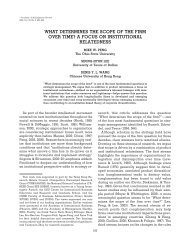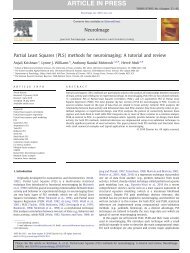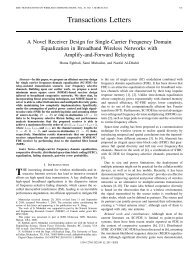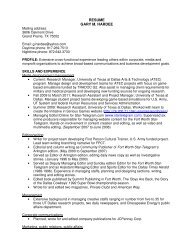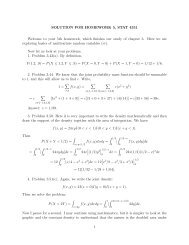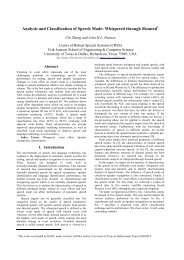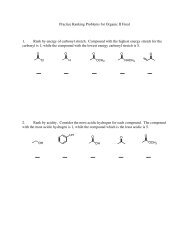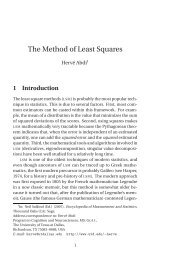Curriculum Vitae - The University of Texas at Dallas
Curriculum Vitae - The University of Texas at Dallas
Curriculum Vitae - The University of Texas at Dallas
You also want an ePaper? Increase the reach of your titles
YUMPU automatically turns print PDFs into web optimized ePapers that Google loves.
Section 3: SYNOPSIS OF RESEARCHMy research combines theory and practice. During the past 30+ years I have utilized my PhD research intheory <strong>of</strong> comput<strong>at</strong>ion and complexity theory with my systems expertise in industry to develop prototypesbased on fundamental principles. Much <strong>of</strong> my research during this time was on the design anddevelopment <strong>of</strong> secure d<strong>at</strong>a management systems based on fundamental principles. A synopsis <strong>of</strong> myresearch follows.After I finished my PhD, starting in 1980, I continued with my research in computability theory andpublished four papers on my thesis work. <strong>The</strong>y are: (i) Cylindrical Decision Problems for SystemFunctions in the Notre Dame Journal <strong>of</strong> Formal Logic in 1983; System Functions and their DecisionProblems, in Zeitschrift fur M<strong>at</strong>hem<strong>at</strong>ische Logik und Grundlagen der M<strong>at</strong>hem<strong>at</strong>ik. (M<strong>at</strong>hem<strong>at</strong>ical LogicQuarterly) in 1984; <strong>The</strong> Concept <strong>of</strong> N-Cylinder and its Applic<strong>at</strong>ion in Zeitschrift fur M<strong>at</strong>hem<strong>at</strong>ische Logikund Grundlagen der M<strong>at</strong>hem<strong>at</strong>ik in 1986; and Reducibility Rel<strong>at</strong>ionships Between Decision Problems forSystem Functions in Zeitschrift fur M<strong>at</strong>hem<strong>at</strong>ische Logik und Grundlagen der M<strong>at</strong>hem<strong>at</strong>ik in 1987. Untilmy research, there was no generalized framework to study different classes <strong>of</strong> decision problems. In otherwords, recursion theoretic properties were studied for individual problems such as the halting problem, thederivability problem and the confluence problem. With my framework, we were able to study theindividual problems with the generalized classes. This was a major breakthrough <strong>at</strong> th<strong>at</strong> time. I develepedcounter-examples for properties th<strong>at</strong> could not be proved. This was achieved by the concept <strong>of</strong> N-Cylinderwhich I defined. N-Cylinder was an extension <strong>of</strong> Paul Young’s semi-cylinder. By using the N-Cylinder, Iwas able to show th<strong>at</strong> the general confluence problem was neither recursive nor a cylinder while JohnCleave (my advisor <strong>at</strong> the <strong>University</strong> <strong>of</strong> Bristol) was unable to prove this result back in the early 1970swith the use <strong>of</strong> Young’s semi-cylinder.Between 1980 and 1983, while <strong>at</strong> the New Mexico Tech and <strong>at</strong> the <strong>University</strong> <strong>of</strong> Minnesota, I continuedto work on this topic and produced five more journal papers: Represent<strong>at</strong>ion <strong>of</strong> One-One Degrees byDecision Problems in the Journal <strong>of</strong> Computer and Systems Sciences in 1982; Some Elementary ClosureProperties <strong>of</strong> N-Cylinders in the Notre Dame Journal <strong>of</strong> Formal Logic in 1983; <strong>The</strong> Concept <strong>of</strong> N-Cylinder and its Rel<strong>at</strong>ionship to Simple Sets in the Notre Dame Journal <strong>of</strong> Formal Logic in 1983;Represent<strong>at</strong>ion <strong>of</strong> One-One Degrees by N-Cylindrical Decision Problems in Zeitschrift furM<strong>at</strong>hem<strong>at</strong>ische Logik und Grundlagen der M<strong>at</strong>hem<strong>at</strong>ik in 1988; and System Function Languages inM<strong>at</strong>hem<strong>at</strong>ical Logic Quarterly in 1993. Furthermore, there were some questions th<strong>at</strong> John Cleave posed inhis work in the early 1970s which I solved in the early 1980s. Particularly interesting was the followingquestion: could every one-one degree be represented by a particular decision problem? Cleave had shownth<strong>at</strong> every m-degree could be represented by a decision problem in the early 1970s which was a weakerresult. Cleave believed th<strong>at</strong> the answer to this question would be a major breakthrough as this would showthe existence <strong>of</strong> decision problems th<strong>at</strong> are Simple. In fact this was the first problem I worked on after myPhD. It was published in the prestigious Journal <strong>of</strong> Computer and Systems Sciences. This work wouldl<strong>at</strong>er (1989) help me prove th<strong>at</strong> the inference problem was unsolvable, a significant development ind<strong>at</strong>abase security.Between January 1984 and January 1986, I worked <strong>at</strong> Control D<strong>at</strong>a Corpor<strong>at</strong>ion as I wanted to get realworld industrial experience working in a product development environment in computer networks anddistributed systems so th<strong>at</strong> I get a feel for how systems really work. During this time I started research insecure dependable distributed systems th<strong>at</strong> would complement my work <strong>at</strong> Control D<strong>at</strong>a Corpor<strong>at</strong>ion. Icollabor<strong>at</strong>ed with Pr<strong>of</strong>. W. Tsai and his student <strong>at</strong> the <strong>University</strong> <strong>of</strong> Minnesota and together we addressedthe challenging problem <strong>of</strong> fault tolerance in a binary tree task model. Prior work had focused on a treewith a single child. We felt th<strong>at</strong> binary tree model would be more realistic as tasks usually spawn multipletasks. After several years <strong>of</strong> work, we published our research in IEEE Transactions on S<strong>of</strong>twareEngineering..Due to my increasing interest in secure systems, I joined Honeywell in January 1986 as I felt having aresearch-oriented job would strengthen my research in secure systems. I started working in the challengingarea <strong>of</strong> secure d<strong>at</strong>a management. I was part <strong>of</strong> a team designing one <strong>of</strong> the two prominent high assurance7



